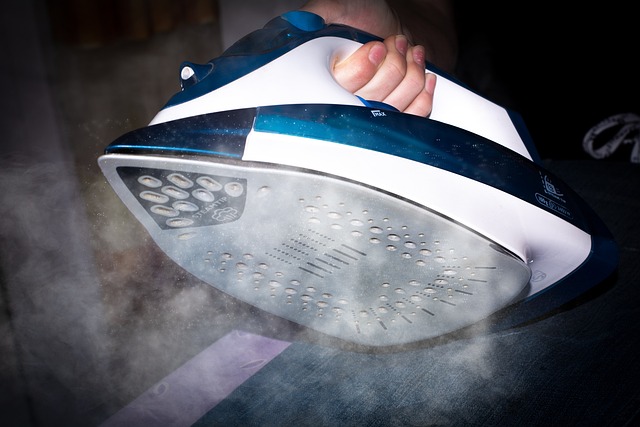Steam cleaning is a powerful, eco-friendly method for deep cleaning various surfaces using high-pressure steam to loosen and remove dirt, grime, and bacteria without harsh chemicals. It effectively sanitizes and deodorizes, breaking down oil and grease in sensitive areas like homes, commercial spaces, and medical facilities. The process involves transforming water into heated steam (above 100°C) that penetrates crevices, fabrics, and pores to eliminate stains, germs, and allergens. Choosing the right steam cleaner based on surface types and adjusting temperature settings ensures efficient cleaning tailored to specific needs. Deep steam cleaning at home requires proper preparation, a systematic approach, and safety precautions to optimize results and maintain a clean, healthy environment. Regular maintenance is vital for consistent impressive performance.
Deep steam cleaning is a powerful and effective method for achieving comprehensive sanitization and surface renewal. This article provides an in-depth look at steam cleaning, from its fundamental principles to its diverse applications. We explore the science behind steaming, highlighting its benefits across various surfaces, and guide you through selecting the right equipment, step-by-step cleaning processes, common pitfalls to avoid, essential health and safety precautions, and maintenance tips for optimal results. Uncover the transformative power of deep steam cleaning in this comprehensive overview.
Understanding Steam Cleaning: A Comprehensive Overview

Steam cleaning is a powerful and effective method for deep cleaning various surfaces, from carpets to tiles and even upholstery. It involves using high-pressure steam to loosen and remove dirt, grime, and bacteria, leaving behind a fresh and hygienic space. This technique has gained popularity due to its ability to deliver exceptional cleaning results while being environmentally friendly and cost-effective compared to traditional chemical-based cleaners.
At its core, steam cleaning leverages the heat energy of steam to create a powerful cleaning agent. The hot steam penetrates deep into pores and crevices, breaking down oil, grease, and other debris. As the steam cools, it condenses, drawing out impurities and leaving surfaces spotless. This process is especially beneficial for sensitive areas as it avoids the use of harsh chemicals, making it a preferred choice for homes, commercial spaces, and even medical facilities where hygiene is paramount.
The Science Behind Steaming: How It Works

Steam cleaning is a powerful and effective method that harnesses the natural power of steam to deeply clean various surfaces. The science behind it is quite simple yet impressive. Water is heated to high temperatures, typically above 100°C, turning it into steam. This steam is then directed onto targeted areas, where it expands rapidly and penetrates deep into crevices and fabrics.
The steam’s hot temperature and pressure break down dirt, grime, and even tough stains, allowing them to be easily lifted away. Unlike traditional cleaning methods that rely on harsh chemicals, steam cleaning offers a chemical-free approach, making it a preferred choice for those concerned about the health and environmental impact of cleaning products. This method is particularly effective for sanitizing and deodorizing surfaces, as the high temperature kills germs and bacteria without leaving behind any residual chemicals.
Benefits of Deep Steam Cleaning for Various Surfaces

Deep steam cleaning offers a multitude of benefits, making it an excellent choice for maintaining various surfaces. For hard floors, such as tile or wood, steam cleaning effectively removes dirt, grime, and even tough stains without the need for harsh chemicals. This gentle yet powerful method leaves floors feeling refreshed and looking new, preserving their natural beauty and longevity.
When applied to fabrics, deep steam cleaning is a game-changer. It thoroughly cleanses upholstery, carpets, and drapes by eliminating bacteria, dust mites, and allergens, ensuring a healthier living environment. Unlike traditional cleaning methods that might leave residue or require lengthy drying times, steam cleaning dries quickly, minimizing disruptions and allowing for faster use of the cleaned areas.
Choosing the Right Steam Cleaner for Your Needs

When it comes to deep steam cleaning, selecting the ideal steam cleaner is key to achieving optimal results and making the task more efficient. The market offers a wide array of options, from handheld portables to full-sized machines suitable for commercial use. Consider your space size and type; for instance, a small apartment might require a lightweight, portable model, while a large house or business premises will benefit from a more powerful, heavy-duty machine.
Additionally, think about the specific areas you intend to clean. Certain steam cleaners come with various accessories tailored for different tasks, such as hard floors, carpets, or upholstery. Some models offer adjustable temperature settings, which are ideal for diverse surfaces and cleaning requirements. By matching your needs with the right features, you can ensure a thorough and effective deep steam cleaning experience.
Step-by-Step Guide to Deep Steam Cleaning at Home

Deep steam cleaning at home is an effective and eco-friendly way to thoroughly clean various surfaces, from floors and carpets to upholstery and kitchen appliances. Here’s a step-by-step guide to help you get started.
1. Prepare Your Space: Clear any furniture or obstructions from the area you plan to clean. Ensure good ventilation by opening windows or using exhaust fans. Gather all necessary tools: a steam cleaner, cleaning solutions (if required), rags, and buckets.
2. Choose the Right Steam Cleaner: Select a machine suitable for your surface types. Some steam cleaners come with multiple attachments designed for different tasks, like cleaning hard floors, tiles, carpets, or upholstery. Follow the manufacturer’s instructions to set up and fill the water tank.
3. Test on a Small Area First: Before applying steam to larger surfaces, test it on a small, less visible area to ensure it doesn’t cause any damage or discoloration.
4. Clean Surface Thoroughly: Move the steam cleaner in straight lines, covering the entire surface evenly. For hard floors and tiles, use a back-and-forth motion. On carpets, follow the pile direction. For upholstery or curtains, gently clean to prevent fiber damage.
5. Follow Up with Dry Cleaning (if needed): While steam cleaning effectively removes dirt and grime, some areas may require additional dry cleaning for deep-seated stains or tough spots. Use appropriate cleaning solutions and rags for these tasks.
6. Wipe Down and Air Dry: After steam cleaning, use a clean rag to wipe away any excess moisture. Allow the surface to air dry completely before using it again.
Common Mistakes to Avoid During Steam Cleaning

When it comes to deep steam cleaning, there are several common mistakes that homeowners often make. One of the biggest blunders is attempting to clean too many surfaces at once. Overloading your schedule can lead to rushed work and subpar results, defeating the purpose of a thorough cleaning. Instead, prioritize tasks and tackle one area—such as bathrooms or kitchens—at a time for optimal efficiency.
Another mistake to avoid is not preparing the space adequately. Steam cleaners require clear access to all areas to be cleaned. Cluttered rooms can hinder progress and prevent the steam from reaching embedded dirt and grime. Declutter beforehand, move furniture away from walls, and ensure good ventilation to maximize the cleaning power of steam.
Health and Safety Precautions for Steam Cleaning

When engaging in steam cleaning, prioritizing health and safety is paramount. Always ensure proper ventilation in the cleaning area to mitigate the risk of respiratory issues caused by inhaling steam. Wear protective gear such as gloves, goggles, and a respirator mask to shield yourself from potential burns, irritation, or allergic reactions. Keep cleaning solutions and hot water away from children and pets to prevent accidents. Additionally, be mindful of slippery surfaces after steaming, as they can increase the risk of falls. Regularly inspect and maintain your steam cleaner to ensure its safety and efficiency.
Maintenance Tips for Optimal Steam Cleaning Results

Regular maintenance is key to achieving the best results from your steam cleaning sessions. Start by ensuring your steamer is properly heated before use, allowing for optimal steam flow and penetration. After each use, thoroughly clean the steamer according to the manufacturer’s instructions, removing any mineral buildup or debris. Empty and dry the water tank completely to prevent bacteria growth. Don’t forget to regularly inspect and replace any worn-out parts, such as hoses or nozzles, to maintain peak performance. Additionally, keeping your floors in good condition, like repairing cracks and sealing gaps, will enhance the effectiveness of steam cleaning by allowing deeper penetration into hard-to-reach areas.
To maximize efficiency, schedule regular deep cleaning sessions, focusing on high-traffic zones that tend to accumulate more dirt and grime. Use appropriate cleaning solutions designed for steam cleaners to cut through tough stains and leave your floors sparkling clean. Remember, consistent care will extend the life of your steamer and ensure impressive steam cleaning results for years to come.
